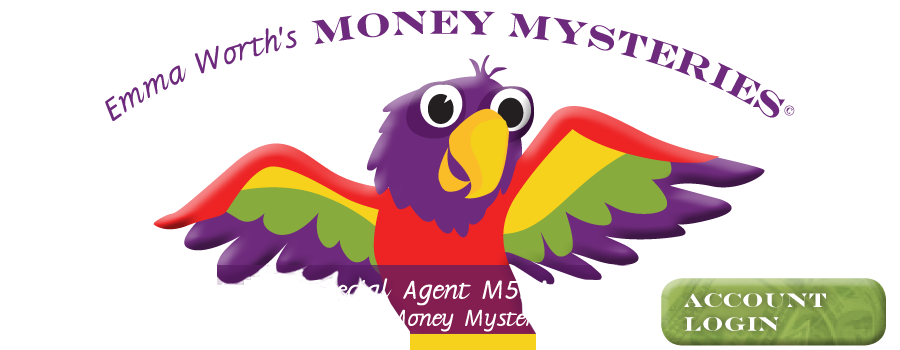Emma Worth lives in a suburban neighborhood. One day, she's staring longingly at a $100 BMX bike in a store window. "Save now, I'll show you how," squawks a Macatoo, and flies away. When she gets home, Emma asks her parents for money to buy the bike. "Money doesn't grow on trees," they say. And Emma comes up with her first mystery: Then where does money grow?
Emma notices the line at the ATM machine at the Gold N Trust Bank, and observes people taking out money. She wishes she could get money as easily. Moolah comes back and says (in the rhymes that characterize Moolah's wise advice) to stick with him and he'll help her out. With the help of Moolah, and her friends Ch-ching, Goldie, and Penny, Emma solves the mystery: Where does money grow?, discovering it first hand when she begins to earn money, opens her own bank account, deposits money into her lockbox, uses the coin counter at the bank, deposits the money, checks her balance on her own banking "app" where she enters her secret password, and discovers how money is earned.
Where the Money Grows
"Where The Money Grows" is a play on words of the time worn and outdated cliché: Money Doesn't Grow on Trees, often evoked by parents to avoid explaining the concept of money to their children. It deals with the visible sights and sounds of our financial system—money, banking and credit cards, the ATM machine. It explains how money appears to a child as coming from the magical wall of an ATM machine. It explains how a plastic card turns into a bicycle. It teaches about Interest, that which a bank pays (good Interest) and that which it charges (not-so-good Interest).
How Can Grandma Have So Much Money When She Doesn't Work?
Emma and her sister Goldie suspect their grandparents are thieves. How else could they have so much money if neither of them has worked in ten years? In this book, children will learn about workplace retirement programs and the receipt of social security benefits.
What's That Rainbow on the TV?
Twins Nate and Kate suspect that their parents are robots who get messages from a rainbow-like thing on their TV screen. They get so focused on the numbers, they don't notice anything else around them and because of this, the twins are often late to school. Emma helps them get to the bottom of it. In this book, children will learn how the parade of colorful lines running across the bottom of the TV is tied to both money and investments, and to Mom and Dad's work.
Emma's Fabulous Wall Street Adventure
In this book, children will learn the concept of stock ownership, its relation to real money and its ability to deploy savings into productive activities. It uses the building and growth of a toy factory to create relevance to the learning child.
Water Falls and Money Flows
Emma's friend Cha-ching Ling wonders how, with all the jobs he's had, he never has any money. And Emma helps him discover that he's spending everything. He needs to balance his spending and saving.
In this book, children will discover the analogy of maintaining water temperature using the hot & cold faucet to explain the concept of varying amounts of saving and spending and its result on the accumulation of wealth, deficits and cash flow.
The Build-Buy Dilemma
Max, a new kid, seems to have everything. His room is full of toys, his yard is full of cars, and he's always bragging about the vacations he's been on. The other kids are jealous, and Emma is surprised when Max hires her to find out why his dad has been not answering phone calls and not opening mail. It turns out his dad has bought things with credit that he can't afford to pay for. Max and Emma learn that this is NOT the way to use credit when they see Max's parents' bank statement. Emma takes notes about the statement and credit.
This book deals with the concepts of consuming more than you produce (balance of trade), valuing goods and services, and allocating financial resources through planning, saving and investing. It uses the story of building vs. buying a scooter as the teaching mechanism.
Huh? There's No Free Lunch?
Camille Casey, Emma's rival sleuth, hires her to find out why the school wouldn't give her lunch because her food money balance was at zero, when they give it to Tony every day, who never has to pay. They find out about free lunch plans, who get them and how they work. This book deals with the notion of paying taxes and receiving its benefits (entitlement programs). The story focuses on a program for paying for a child's lunch at school to teach about taxes and the funding source of this and other such programs.
Finders-Keepers, Losers-Weepers
Goldie brings her friend Annie to Emma to see if she can find her doll. Emma reminds them that she only deals with money cases but she can't say no to a crying girl. In the end, Emma doesn't regret taking the case because she learns all about insurance. This book deals with the concept of insurance through the story of a child losing a precious toy and someone buying a replacement.
